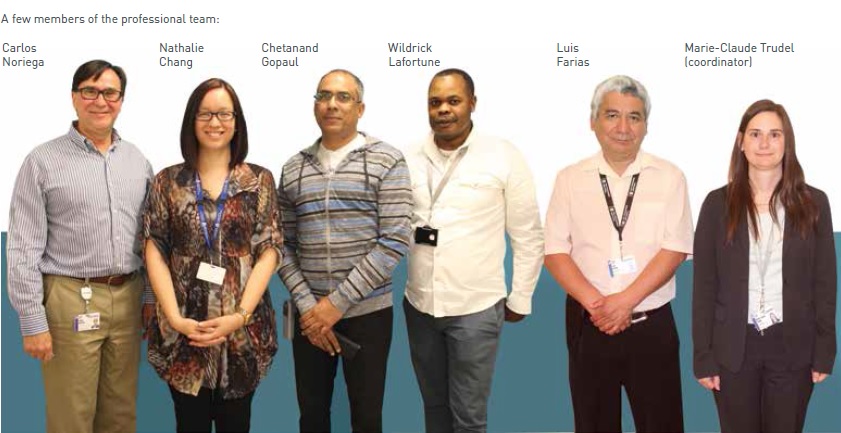An informed and dedicated team oversees a large inventory that's crucial to treating our patients
From the simplest machines to the most complex, the huge inventory of biomedical equipment used by the McGill University Health Centre (MUHC) includes an amazing variety of devices available to meet many needs at the MUHC. This could include anything from stretchers to perfusion pumps, CT scan to monitors or surgical anesthesia machines to laboratory equipment. And behind it all are about 50 dedicated employees whose sense of innovation and expertise are key for the maintenance, updating and use of this inventory.
The Biomedical Technology Management unit isn’t exactly the MUHC’s best-known team. But their role is truly important, not only because they oversee some 80,000 pieces of equipment – both medical and non-medical – throughout the MUHC, but also because they have the technological know-how required for the acquisition of new equipment and the responsibility for its upkeep and repair.
A portion of the team, consisting of technicians, coordinators, engineering professionals and administrative clerks, is based at the Glen site. Others are at the Montreal General and the Montreal Neurological hospitals. Soon, there will also be someone at the Lachine Hospital to offer local support.

“Every day, our technicians and biomedical engineers make sure that the equipment is in good condition, meets all requirements, and is safe and functional,” says Marie-Claude Trudel, the service’s coordinator. “The end goal is always to contribute to excellent care with the help of technology that is effective and safe, both for the patients and the caregivers.”
The team is implementing a program focused on technology control and management that also includes a systematic inspection of the safety of electrical systems and the functioning of new medical equipment, as well as a follow-up on equipment performance.

“If I get a call about a configuration problem, or a piece of equipment for which I’m responsible for and it breaks down, I have to evaluate whether I have the ability and expertise to intervene or make a repair,” says Theodore Patrinos, a technician and biomedical engineer.
“If it isn’t within my skill set, I have to contact the company, the manufacturer or the distributor.”
In addition to upkeep, emergency adjustments, and repairs offered by the unit’s technicians and coordinators, technical assistance is also available to caregivers and administrators.
“When a clinical team notifies us that they need new equipment, they have to follow an established procedure,” explains Carlos Noriega, a biomedical technology specialist. “After the project and its budget are approved by all the necessary parties, our team comes into play. We meet with all the people involved, determine their exact needs, learn exactly what equipment they want and why, and advise them to the best of our abilities.”
When a piece of equipment reaches the end of its useful life, it can be replaced by a new version of the same type or by a newer technology. “That choice is always made in accordance with the needs of the clinicians, with our support,” adds Carlos. “We’re always there to serve the clinical team.”
Since medicine is a field in which innovation is frequent and numerous, Biomedical professionals keep a close watch both on technology that comes on the market and on recommendations and alerts put out by various national and international organizations, always with the objective of having up-to-date and safe equipment, machines, and facilities.
“We keep an eye on the marketplace, note recent technological advances, and make sure they meet the appropriate standards,” says Carlos. “We follow up by producing a technical paper on which to base offers to buy new equipment.”
In fact, these professionals participate in the acquisition process from start to finish, from project proposal all the way to installation. “We have to know where the device will go, whether something else has to move in order for it to be installed, if access to electrical power needs to be modified, etc,” explains Luis Farias, a senior adviser.
 The service also offers support for reviewing how equipment should be used. “About 70 per cent of the requests for our services are a result of suboptimal use of the equipment or an insufficient understanding of how various pieces of equipment are integrated,” explains Vincent Brissette, a technical coordinator.
The service also offers support for reviewing how equipment should be used. “About 70 per cent of the requests for our services are a result of suboptimal use of the equipment or an insufficient understanding of how various pieces of equipment are integrated,” explains Vincent Brissette, a technical coordinator.
“In those situations, I have to first correct the situation and ensure that the procedure being undertaken is safe for both the patient and the clinical personnel. Depending on the complexity of the technology, I might then also offer training in collaboration with the person in charge of the clinic.”
The team is also responsible for adapting equipment, making sure that it is well integrated into its environment and meets specific needs. The move to the Glen site magnified the need for this kind of work, since they had to oversee the installation of both old and new equipment in brand new spaces.
Fortunately, the team can always count on the essential support provided by the five clerks who keep matters moving smoothly, overseeing work orders, communicating with suppliers, and more. “Following up with both clients and suppliers is crucial in order to make sure that equipment is available for use as quickly as possible after a repair,” explains Nancy Marino.
It sometimes happens that the team is called upon to solve a problem with a piece of equipment and that no solution even exists for that problem. In these cases, a custom piece might actually be created to meet the exact needs of the users. “That does happen, but it’s not a frequent event,” notes Marie-Claude.
Frequent or not, such cases demonstrate the devotion, determination, and resourcefulness of this outstanding team.
